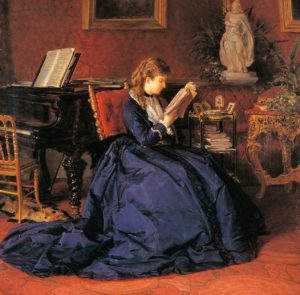Novel Reading
Lots of today’s innocent pleasures were at one time considered immoral. Dancing, card-playing, and theater are a few of the most obvious examples. Less well remembered is one of the most insidious vices of the past—novel reading.
Novels were attacked as promoting idleness and as being distractions from serious studies. Some churches declared novels to be instruments of the devil. The pioneering psychiatrist Benjamin Rush claimed that booksellers were particularly prone to mental illness, due to their exposure to novels. During the Victorian era, novel-reading was considered especially morally dangerous to women. There were medical professionals who identified them as a leading cause of suicide among women (evidently depressed because their lives didn’t match those of the characters in novels). According to Barbara Benedict, a professor of English literature at Trinity College, “novel reading for women was associated with inflaming of sexual passions; with liberal, radical ideas; with uppityness; with the attempt to overturn the status quo.” Flaubert’s masterpiece Madame Bovary tells the story, ironically, of a woman who ruins her life as a result of reading novels.
Fortunately, the fear of novels had been tossed into history’s moral dustbin, along with the fear of theater. For what it’s worth, we encourage you to all consider buying good books as Christmas gifts this year.
Pic: The image is Anton Weber’s 1880 painting “The Reader.”
